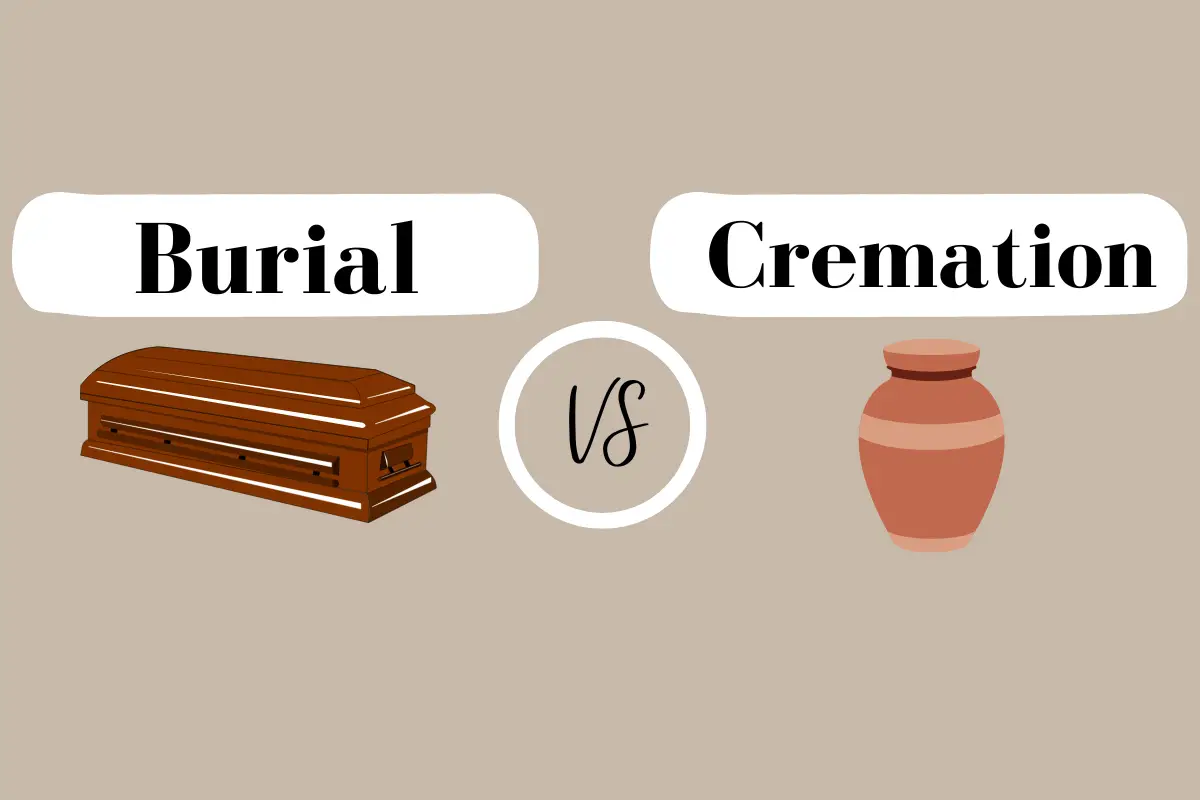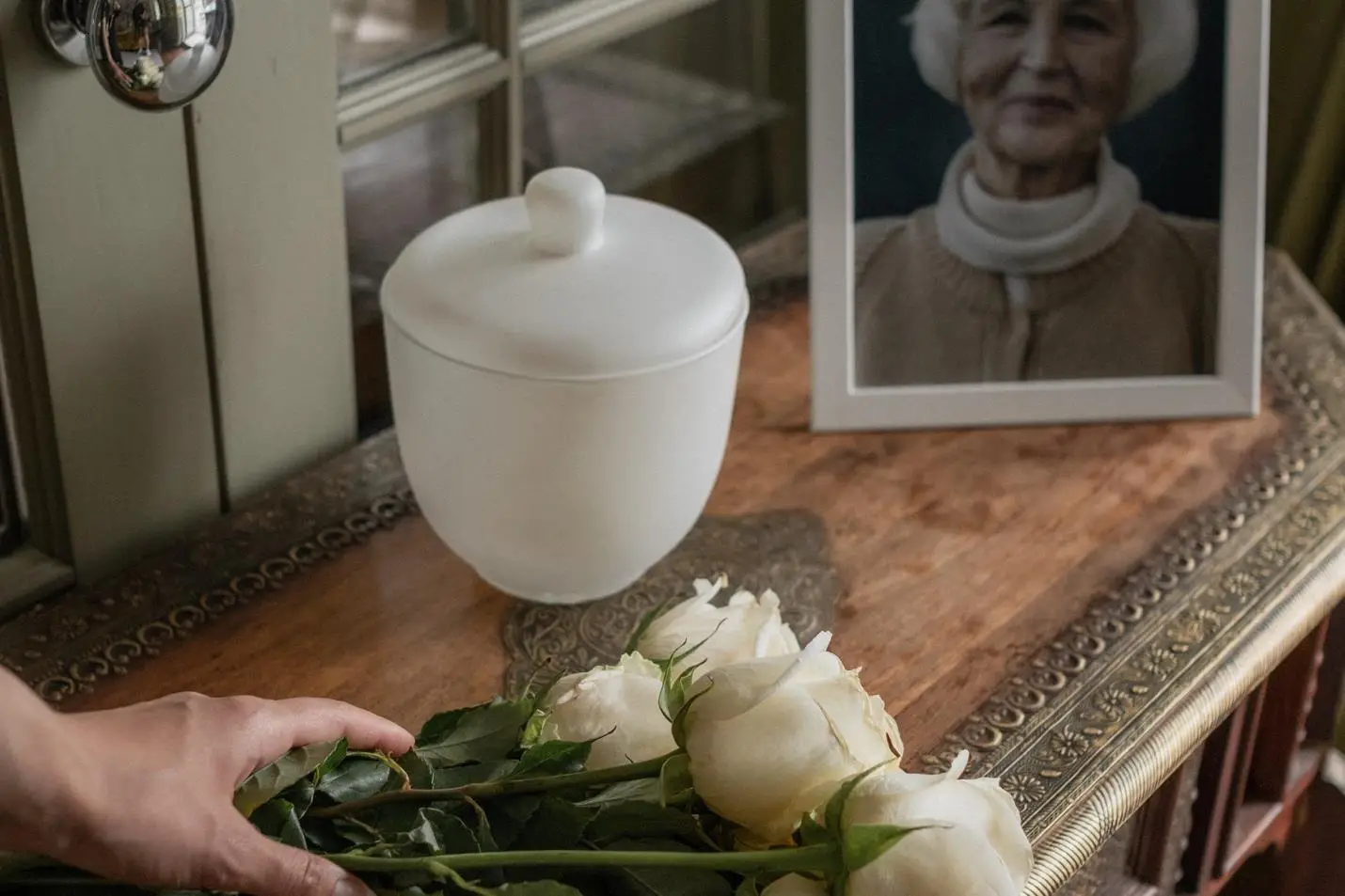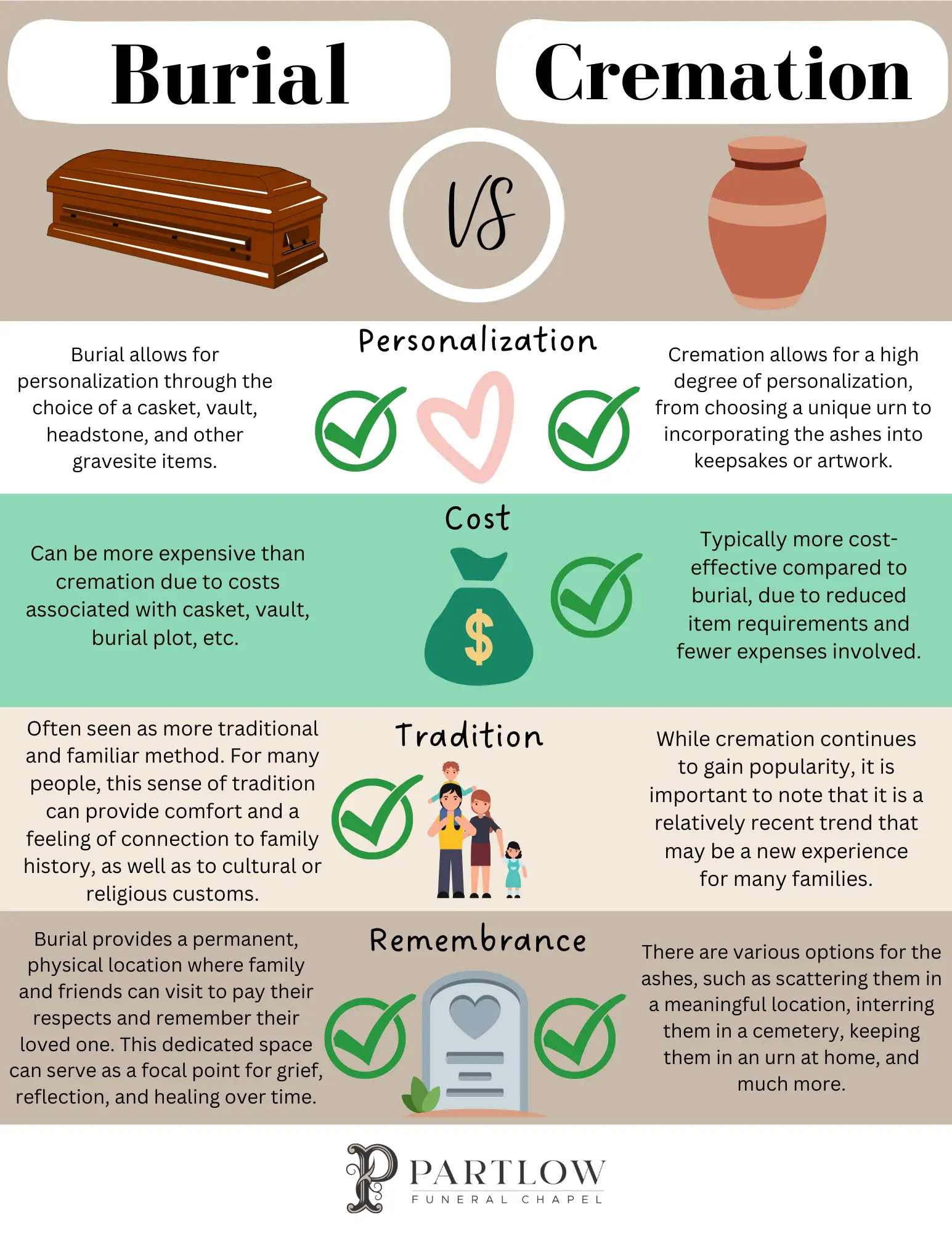Cremation vs. Burial
A Comprehensive Guide to Help You Decide
One of the first decisions that needs to be made when deciding on funeral arrangements is a method of disposition. Disposition refers to the way a deceased’s body will be laid to rest, either through cremation or burial.

Planning a funeral, whether it's for a loved one or for yourself, can be a difficult task. With so many options and decisions to make, it's natural to feel a bit overwhelmed. One of the first decisions that needs to be made when deciding on funeral arrangements is a method of disposition. Disposition refers to the way a deceased’s body will be laid to rest, either through cremation or burial. In this article, we want to help you navigate the differences between cremation and burial so you can make the best decision for yourself or your loved ones, ensuring a meaningful and fitting farewell.
Cremation

What is cremation and how does it work?
Cremation is a method of handling a person's remains after they have passed away by reducing their body to ashes. This process involves placing the body in a special chamber, where it is exposed to high heat and flame. Within a few hours, the body is transformed into ashes, which can then be collected and placed in an urn or another container of your choice. In this section, we'll delve deeper into the different types of cremation services, along with the benefits and drawbacks, to help you gain a better understanding of this option and decide if it's the right choice for you or your loved one.
What are the different types of cremation services?
Direct Cremation
This is the simplest and most cost-effective option. With direct cremation, the body is cremated shortly after death without a formal funeral service.
Cremation with a Memorial Service
In this case, the cremation can take place before or after the ceremony, depending on if the ashes are to be present. This type of cremation service is similar to a traditional funeral service but without the body present. This allows for a personalized event, where you can choose the location, readings, music, and more. There may be a visitation before the memorial service as well.
Cremation with a Traditional Funeral Service
Similar to a burial service, a traditional funeral takes place before the cremation. The body is embalmed and placed in a ceremonial or cremation casket for viewing and visitation, followed by a ceremony at a funeral home, church, or other venue. Afterward, the cremation occurs, and the ashes can be interred, scattered, or kept by the family.
What are the benefits of cremation?
- Cost: Cremation is generally more affordable than burial, as it involves fewer expenses. With cremation, you can save on or eliminate the costs associated with purchasing a casket, vault, burial plot, and headstone. This may allow less expense overall, or the ability to allocate funds towards other memorialization options.
- Flexibility: One of the significant benefits of cremation is the flexibility it offers in terms of memorial services and handling the ashes. You can choose to have a memorial service before or after the cremation, at a location and time that suits your needs. Additionally, you have various options for the ashes, such as scattering them in a meaningful location, interring them in a cemetery, keeping them in an urn at home, and much more.
- Personalization: Cremation allows for a high degree of personalization in honoring your loved one's memory. From choosing a unique urn to incorporating the ashes into keepsakes or artwork, you can create a meaningful and lasting tribute that reflects the deceased's personality, interests, and life story.
- Easier transportation: If your loved one wished to be laid to rest in a distant location or if family members live far away, transporting ashes is generally easier and less costly than transporting a casketed body. This can be especially helpful for families who are spread out geographically and want to gather in a specific place for a memorial service or interment of the ashes.
What are some drawbacks of cremation?
- Irreversible process: Cremation is final and cannot be undone, which can be a challenging concept for some family members. Once the decision is made, there is no possibility of changing the method of disposition. It's important to have open conversations with your family to ensure everyone is comfortable with the decision.
- Emotional impact: For some people, the idea of their loved one's body being cremated might be too difficult to bear. Some individuals may prefer the concept of burial, as it offers a more traditional and tangible connection to the deceased. It's essential to consider the feelings and preferences of all family members when deciding on cremation.
- Lack of a physical gravesite: With cremation, there might not be a permanent gravesite or memorial location where family and friends can visit and pay their respects. While some people find comfort in keeping their loved one's ashes close by or scattering them in a special place, others might prefer the sense of connection that comes from visiting a physical gravesite.
- Cultural or religious considerations: Some faiths and cultures discourage or forbid cremation, so it's essential to take this into account when making your decision. Be sure to consult religious or cultural leaders if you have any concerns or questions about the appropriateness of cremation within a particular tradition.
What are the current trends in cremation?
Cremation has become increasingly popular in recent years, with more and more people opting for this choice. Various factors have contributed to this trend, including cost, flexibility, and changing societal norms.
As more families choose cremation, many funeral homes are adapting to better serve their needs. At Partlow Funeral Chapel, we have installed our own on-site crematory to provide families with the highest level of service and care. By managing the cremation process in-house, we are able to maintain strict safeguards and ensure quality control every step of the way. Having our own crematory allows us to be more directly involved in the process, ensuring those we serve are treated with the utmost respect and dignity.
Burial

What is burial and how does it work?
Burial is the traditional practice of placing the deceased’s body in a casket and interring it in a grave or tomb. This process typically involves a funeral service or a graveside ceremony, followed by the burial at a cemetery or another designated location. Depending on your preferences, you can choose from different types of burial services.
What are the different types of burial services?
Traditional burial
In a traditional burial, the body is usually embalmed, placed in a casket, and then interred in a cemetery plot. A funeral service or graveside ceremony is held to honor the deceased, often including readings, prayers, songs, and eulogies.
Above-ground burial (mausoleums)
In this type of burial, the body is placed in a crypt or niche within a mausoleum, which is an above-ground structure. Mausoleums can be privately owned by families or shared as community spaces. This type of burial will usually still involve a visitation and/or funeral service beforehand.
Green burial
This eco-friendly option aims to minimize the environmental impact of burial by forgoing embalming and using biodegradable caskets or burial shrouds. Green burials take place in designated natural burial grounds or specific sections of traditional cemeteries.
What are the benefits of burial?
- Traditional and familiar: Burial is often seen as a more traditional and familiar method of laying a person to rest. For many people, this sense of tradition can provide comfort and a feeling of connection to family history, as well as to cultural or religious customs.
- Physical gravesite: A burial provides a permanent, physical location where family and friends can visit to pay their respects and remember their loved one. This dedicated space can serve as a focal point for grief, reflection, and healing over time.
- Opportunities for personalization: A burial allows for personalization through the choice of a casket, vault, headstone, and gravesite adornments. Family members can work together to create a unique and lasting tribute that reflects the life and personality of the deceased.
- Ceremony and ritual: A burial service often involves ceremonial and ritual elements, such as a funeral or graveside service, which can be a source of comfort and solace for those experiencing the loss. These rituals can help family and friends find closure and come to terms with their loved one’s passing.
- Environmental considerations: Green burials, an eco-friendly alternative, are becoming increasingly popular as people look for ways to minimize their environmental impact. Green burials involve the use of biodegradable caskets or shrouds and avoid embalming chemicals, which can be more sustainable and better for the environment. This option may appeal to those who value environmental conservation and wish to leave a minimal ecological footprint.
What are some drawbacks of burial?
- Cost: Burial can be more expensive than cremation due to the costs associated with purchasing a burial plot, casket, headstone, and other related services. These costs can add up, and for some families, this might be a significant concern when considering their options.
- Limited availability: In urban areas or crowded cemeteries, finding available burial plots can be challenging. This scarcity can lead to increased costs and may limit your options when choosing a final resting place.
- Environmental impact: Traditional burial methods often involve the use of chemicals for embalming and non-biodegradable materials for caskets. This can have a negative environmental impact, which might be a concern for those who prioritize eco-friendly practices.
- Less flexibility: Burial typically involves a more structured timeline for funeral arrangements and services, which may not be ideal for families who need or want more flexibility in planning a memorial service. This is becoming a more common issue with the increase in mobility and loved one’s living further away from one another.
- Permanence: Once a burial has taken place, it is generally considered to be a permanent decision. This permanence might not suit everyone, especially if family members relocate and want to be closer to their loved one's resting place. Unlike ashes, which can be easily transported, relocating a casket and gravesite can be a difficult and costly process.
What are the current trends in burial?
While cremation has gained popularity, burial remains a prevalent choice for many families. Green burials, in particular, have seen increased interest as more people seek eco-friendly alternatives to traditional burial practices. Additionally, some funeral homes and cemeteries now offer customizable options for burial services, allowing families to create a more personalized and meaningful experience. Although we at Partlow Funeral Chapel have made changes to meet the increasing needs of those choosing cremation, we still provide the highest quality and care for those seeking traditional burial options. We work with families to deliver exceptional services at a price appropriate to their needs.
Overview of Important Factors to Consider
- Personal values and beliefs: Consider your own beliefs and those of your loved one when choosing between cremation and burial. This decision should feel authentic and aligned with the values you both hold dear.
- Religious or cultural considerations: Make sure to take into account any religious or cultural requirements or preferences when deciding on a form of disposition.
- Environmental impact: If minimizing your environmental footprint is essential, you might want to consider cremation or green burial as more eco-friendly options.
- Cost and financial planning: Keep your budget in mind when making your decision. It's important to choose a method that's financially feasible without causing undue stress or hardship.
- Family preferences and dynamics: Talk openly with your family members to gauge their thoughts and feelings about the options. It's important to ensure everyone is comfortable with the final decision.

Deciding between cremation and burial is a deeply personal choice that involves considering various factors, such as personal beliefs, cultural or religious preferences, environmental concerns, and budget constraints.
By discussing these options openly with your loved ones and seeking guidance from professionals, you can make a thoughtful and heartfelt decision that honors the memory of the person you've lost.
Remember that you're not alone in this process. If you have any questions that came to mind while reading this article, or would like to discuss other aspects of funeral planning, please feel free to reach out! We at Partlow Funeral Chapel are here for you every step of the way.
